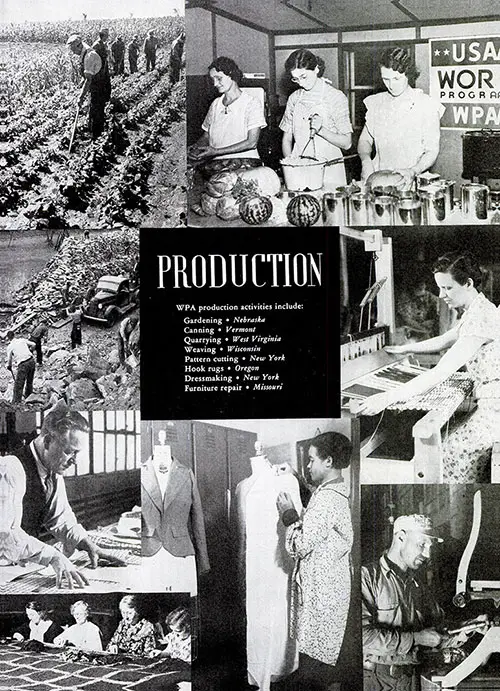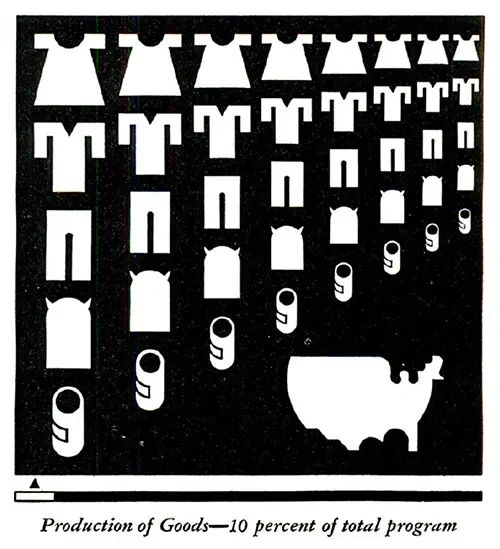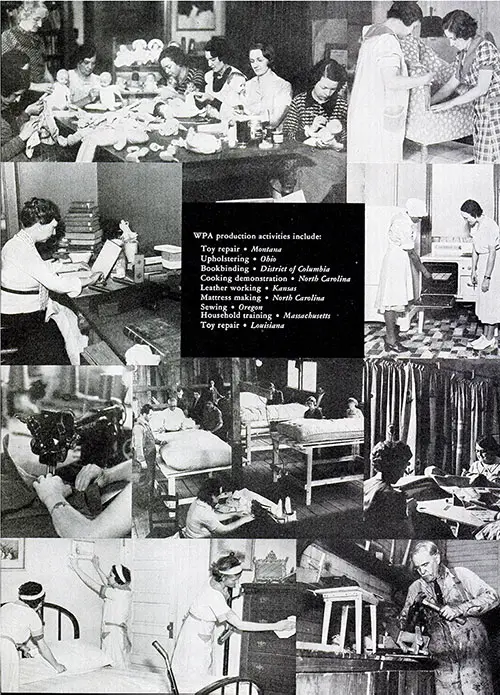🧵 The WPA’s Forgotten Workforce: How Sewing Rooms, Canning Projects, and Handicrafts Sustained Families During the Great Depression
📌 The 1938 WPA report on production activities reveals how workers—especially women—created clothing, preserved food, and revived traditional crafts. Discover how the WPA provided jobs, preserved culture, and supported communities in need.

Collage of WPA Production Activities Including Gardening (Nebraska), Canning (Vermont), Quarrying (West Virginia), Weaving (Wisconsin), Pattern Cutting (New York), Hook Rugs (Oregon), Dressmaking (New York), Furniture Repair (Missouri). Inventory: An Appraisal of Results of the Works Progress Administration, Washington, DC: US Government Printing Office, 1938. | GGA Image ID # 152216c741
🧵 WPA Production Activities - 1938
How the WPA Empowered Workers, Preserved Handicrafts, and Provided Essential Goods
📖 The WPA's 1938 report on production activities showcases how thousands of workers, especially women and unskilled laborers, were employed to produce clothing, preserved foods, furniture, and handicrafts for relief distribution and public use. This effort, comprising 10% of the WPA’s total program, not only sustained the workers but also provided much-needed goods for struggling families and institutions during the Great Depression.
For teachers, students, genealogists, and historians, this document provides:
✔️ A detailed look at Depression-era work programs that helped individuals develop skills for future employment.
✔️ A window into gendered labor roles, especially women’s participation in WPA projects.
✔️ A historical record of how communities leveraged WPA resources to address poverty and unemployment.
✔️ Insights into how WPA projects revived traditional crafts and local industries.
📌 This report highlights the WPA’s social and economic impact, showing how government intervention helped sustain struggling families and preserve American craftsmanship.
Thousands of American communities, to provide employment for women and other persons unsuited either for heavy construction or professional work, have sponsored WPA projects for the production of goods and materials. Such work represents about 10 percent of the entire program.

Subject Matter Index Page for WPA Production of Goods—10 Percent of Total Program. Inventory: An Appraisal of Results of the Works Progress Administration, Washington, DC: US Government Printing Office, 1938. | GGA Image ID # 1522aa40e1
These projects, whether they produced garments or preserved surplus food for free distribution among those unable to buy these necessities, serve the triple purpose
(1) of sustaining the workers,
(2) of saving or improving their ability, and
(3) of reducing the public relief bill to the extent of what these products would have cost.
By far the largest of such groups are the 10,259 WPA sewing rooms in which a small army of needy women, either heads of families or single and "on their own," have produced more than 121,700,000 articles for free distribution by public agencies among the destitute or to tax-supported institutions.
These articles include more than 95,000,000 garments such as shirts, dresses, and underwear. More than 17,000,000 of these have been for men, nearly 25,000,000 for women, 16,000,000 for boys, 22,000,000 for girls, and 16,000,000 for infants.
Other articles include large quantities of sheets, towels, pillowcases, and other linens, while many opportunities have been offered to develop special skills in needlework, weaving, and knitting.
While remarkable ingenuity has been displayed in producing serviceable and attractive garments and articles out of such humble materials as sacking, these projects also have made substantial textile purchases from private industry.
These aggregated over $40,500,000 through October 31, 1937, or nearly 8 percent of the agency's total expenditure for materials, supplies, and equipment. Sewing rooms range in size from modern plants employing hundreds of women to small centers with ten or a dozen workers, depending upon community needs and the number of eligible women available.
All types of clothing are made, from baby layettes to heavy coats and overalls. The training often includes lessons in the selection of materials, tailoring, economy in cutting, and the proper care of clothing.
Many of the women, previously untrained, are equipping themselves not only to supply the needs of their own families, but also to hold private jobs. With the workers available through the WPA, many communities have set up seasonal canning and preserving projects to save surplus fruit, vegetables, and meat for relief distribution which otherwise would have been wasted.
Thus large quantities of surplus meat have been saved, while in fruit- and truck-farming areas, during peak seasons, much valuable food has been gathered and processed. The variety has ranged from surplus fish in Maine to molasses in the South.
The products of thousands of WPA subsistence gardens, and other gardens operated to supply school lunch projects, also have been preserved. In all, WPA workers have canned or preserved more than 36,000,000 pounds of food- stuffs.
To distribute these products, as well as over 675,000,000 pounds of foodstuffs made available by the Federal Surplus Commodities Corporation, required still more WPA personnel. As a result, hundreds of workers have carried out this task for welfare agencies in many communities.
They have distributed, in addition to the foods mentioned above, more than 82,000,000 quarts of milk in liquid or powdered form and nearly 572,000 cords of wood. Here again, the cost of the services performed by these WPA workers otherwise would have fallen upon local resources, or the work would not have been done.
In the same general field, workers on shoe and furniture repair projects have collected and re- habilitated over 600,000 pairs of shoes and nearly 900,000 pieces of furniture, subsequently used by people on relief.
The WPA has enrolled over 15,000 women in training courses for private jobs in the field of household employment. This program, under which capable and reliable women are trained to perform the various duties of the skilled household worker, is designed to raise the standards of the occupation on the part of both employer and employee.
It aims also to place those who successfully complete the training in homes of employers who maintain reasonable standards of work, living conditions, and pay.
Perhaps the most interesting type of goods project which the WPA has been asked to provide is that which renews and preserves age-old arts and crafts, almost lost in this machine age. In many areas where hand-wrought goods are a tradition, where native materials are used and an older generation still cherishes the patterns and the lore, WPA workers are reviving native handicrafts.
The immediate purpose is production of needed articles for hospitals and other public institutions, but the hope is that renewed popular interest in these crafts will make the workers self-supporting. In fact, a substantial number already have left the rolls.
Almost an entire New Mexico village went "off relief" because of the demand for Moorish period furniture produced in its WPA community workshop—furniture authentically copied from that of the early Spanish settlers.
Many of the 40,000 objects and articles thus produced have attracted wide attention . . . Mexican drawn work and lace in the Southwest, Spanish colonial homespun rugs in Colorado, old English homespun linens in Virginia, Indian beadwork and leathercraft, hammered copper, fine pottery, basketry, woodwork, and metalcrafts.

Collage of Additional WPA Production Activities That Include Toy Repair (Montana), Upholstering (Ohio), Bookbinding (District of Columbia), Cooking Demonstration (North Carolina), Sewing (Oregon), Household Training (Massachusetts), Toy Repair (Louisiana). Inventory: An Appraisal of Results of the Works Progress Administration, Washington, DC: US Government Printing Office, 1938. | GGA Image ID # 1522a4acf2
"Production," in Inventory: An Appraisal of Results of the Works Progress Administration, Washington, DC: US Government Printing Office, 1938, pp. 55-58.
Why This Document is Important
📜 Relevance for Different Audiences
✔ For Historians & Economists
🔹 Examines the federal government’s role in employing women and unskilled laborers.
🔹 Reveals how public work programs intersected with welfare relief and economic recovery.
🔹 Provides a foundation for discussions on government job creation programs today.
✔ For Genealogists & Family Historians
🔹 Ancestors may have worked in WPA sewing rooms, canning factories, or craft workshops.
🔹 Relatives in rural areas may have benefited from WPA-produced food, clothing, or furniture.
🔹 The document provides a glimpse into how families survived the Great Depression.
✔ For Teachers & Students
🔹 Provides a case study on Depression-era economic policies and labor programs.
🔹 Illustrates the impact of government intervention in unemployment relief.
🔹 Explores gender roles and how women contributed to the economic recovery.
📌 This document serves as a rich resource for understanding social welfare, public work programs, and community resilience.
::::: Most Engaging & Insightful Content :::::
👚 Sewing Rooms & Textile Production
✔ Why This is Fascinating:
🔹 Over 10,259 WPA sewing rooms operated across the country.
🔹 121.7 million articles of clothing were produced for relief distribution.
🔹 Garments were made for men, women, children, and infants.
✔ Key Takeaway:
The WPA’s sewing projects provided jobs for women while supplying clothing for those in need.
📌 This section highlights how women played a vital role in WPA relief efforts and learned skills that helped them transition to private employment.
🥫 Canning & Food Preservation
✔ Why This is Fascinating:
🔹 WPA workers preserved over 36 million pounds of food to prevent waste and help the hungry.
🔹 Canned goods ranged from surplus meat and vegetables to molasses and fish.
🔹 Food was distributed to relief families, schools, and public institutions.
✔ Key Takeaway:
The WPA helped communities prevent food waste while ensuring nutritional support for the needy.
📌 This section connects to modern food security programs and sustainability efforts.
🛠 Shoe & Furniture Repair
✔ Why This is Fascinating:
🔹 600,000 pairs of shoes and 900,000 pieces of furniture were repaired and distributed.
🔹 Communities repurposed existing materials to provide for struggling families.
🔹 Workers learned valuable repair and restoration skills.
✔ Key Takeaway:
The WPA reduced waste and provided essential goods through sustainable repair practices.
📌 This section highlights how recycling and upcycling played a role in economic recovery.
🏡 Household Employment Training
✔ Why This is Fascinating:
🔹 Over 15,000 women were trained in household work, including cooking, cleaning, and childcare.
🔹 The program aimed to improve job opportunities and professionalize domestic work.
🔹 Women were placed in homes with fair wages and better working conditions.
✔ Key Takeaway:
The WPA helped raise labor standards in domestic work while providing employment opportunities for women.
📌 This section sheds light on historical labor practices and the undervaluation of domestic work.
🎭 Revival of Traditional Crafts & Handicrafts
✔ Why This is Fascinating:
🔹 WPA projects revived Native American beadwork, Spanish colonial weaving, and Appalachian rug hooking.
🔹 40,000 handcrafted objects were created, sparking interest in local artistry.
🔹 Entire communities became self-sufficient through craft production.
✔ Key Takeaway:
The WPA preserved cultural heritage while providing economic opportunities.
📌 This section connects to modern discussions on cultural preservation and economic sustainability.
🖼 Noteworthy Images & Their Significance
🖼 👚 "Collage of WPA Production Activities"
🔹 Depicts sewing, weaving, and dressmaking.
🔹 Illustrates how WPA workers produced essential goods for relief distribution.
🖼 🥫 "Collage of Additional WPA Production Activities"
🔹 Features canning, food preservation, and household employment training.
🔹 Highlights how WPA efforts supported families and institutions.
🖼 🎭 "Collage of Handicraft & Toy Repair"
🔹 Showcases rug-making, toy repair, and furniture restoration.
🔹 Demonstrates WPA’s impact on preserving traditional crafts.
📌 These images visually capture the WPA’s contributions to economic recovery and cultural preservation.
Bias & Perspective Considerations
✔ Pro-WPA Narrative:
🔹 The report emphasizes the WPA’s successes but lacks discussion of inefficiencies or worker grievances.
🔹 Were all workers treated fairly?
🔹 Did some communities receive fewer resources than others?
✔ Limited Discussion of Labor Conditions
🔹 The document does not explore whether WPA wages were livable or how the training translated into long-term employment.
✔ Absence of Criticism from Private Industry
🔹 The WPA competed with private textile and craft industries, yet this tension is not mentioned.
📌 While this document celebrates WPA production efforts, further research is needed to assess long-term employment impact and industry competition.
Final Thoughts: Why This Report Matters
"WPA Production Activities - 1938" provides a crucial historical record of how government work programs sustained American families during the Great Depression. Through sewing rooms, food preservation, furniture repair, and traditional crafts, the WPA helped individuals regain self-sufficiency while supplying essential goods to those in need.
📌 Many of these handcrafted traditions and employment models paved the way for future vocational training and social welfare programs.
💡 The WPA proves that government-led job programs can provide both economic relief and cultural enrichment. 🧵🥫🏡
